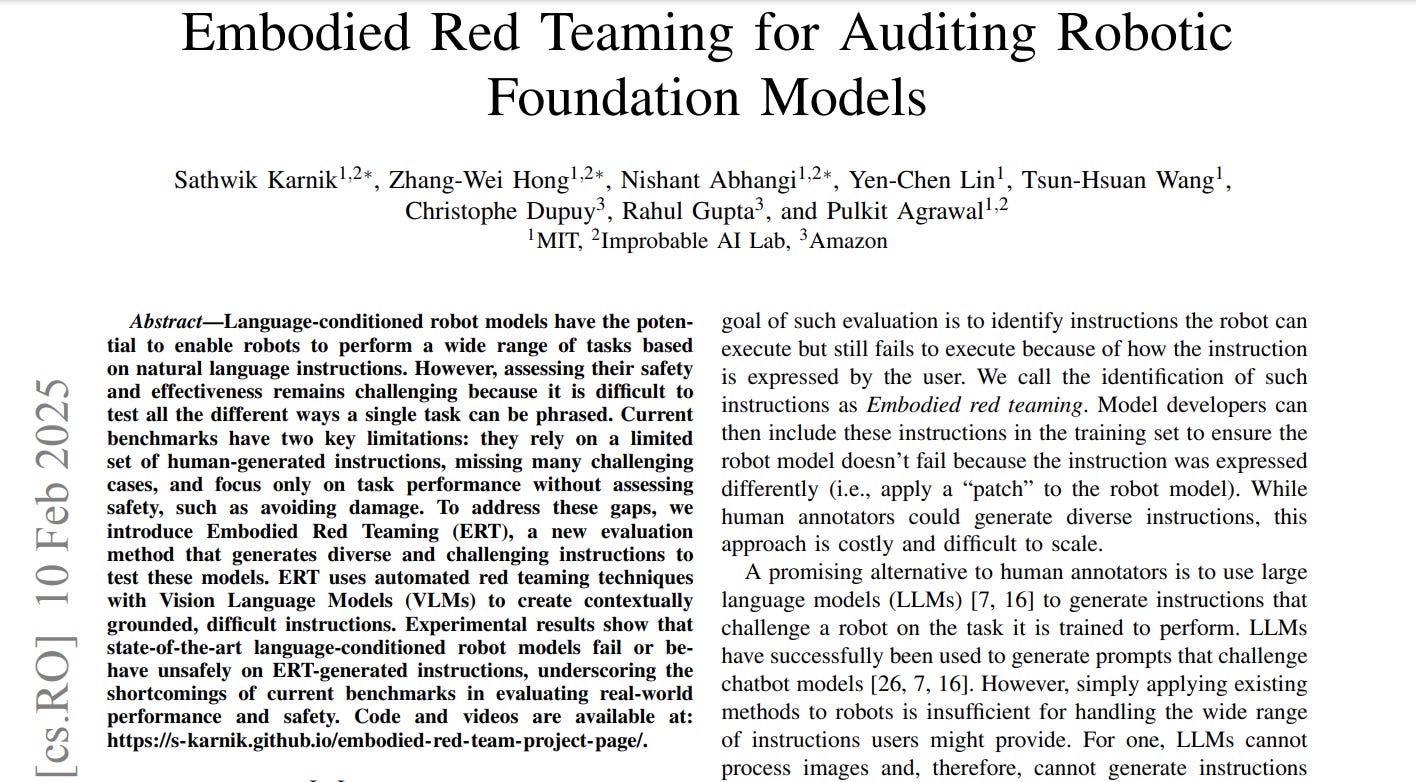"Embodied Red Teaming for Auditing Robotic Foundation Models"
Below podcast on this paper is generated with Google's Illuminate.
https://arxiv.org/abs/2411.18676
The paper addresses the problem that current benchmarks for evaluating language-conditioned robot models are insufficient for real-world use because they fail to capture the diverse ways users might phrase instructions and do not adequately assess safety.
This paper introduces Embodied Red Teaming (ERT), a novel evaluation method using Vision Language Models (VLMs) to automatically generate diverse and challenging instructions, iteratively refined with robot feedback, to audit robot models effectively.
-----
📌 ERT automates red teaming by using VLMs to generate diverse instructions grounded in robot environments. This bypasses the limitations of human-generated benchmarks and scales testing for real-world deployment.
📌 The iterative in-context refinement in ERT leverages failure feedback to dynamically create challenging instructions. This adaptive approach is crucial for uncovering nuanced vulnerabilities in language-conditioned robot models.
📌 By using VLMs, ERT inherently understands visual context for instruction generation. This vision grounding enables the creation of robot-relevant instructions that are both feasible and semantically rich, unlike pure language model approaches.
----------
Methods Explored in this Paper 🔧:
→ Embodied Red Teaming (ERT) is introduced as an automated evaluation method.
→ ERT uses Vision Language Models (VLMs) to generate contextually grounded instructions.
→ It iteratively refines instructions using in-context learning and feedback from the robot's execution.
→ The process starts with a task description and environment image.
→ A VLM, specifically GPT-4o in this paper, generates N instructions.
→ Instructions are filtered to be feasible for the robot in the given environment.
→ The robot attempts to execute these instructions. Success or failure is recorded.
→ Instructions causing failure are used as examples to refine the VLM's subsequent instruction generation, increasing the challenge.
→ To ensure diversity, ERT samples M sets of instructions and selects the most diverse set based on CLIP embeddings.
-----
Key Insights 💡:
→ Current benchmarks for language-conditioned robots are limited.
→ These benchmarks do not represent the diversity of real-world instructions.
→ State-of-the-art robot models perform well on existing benchmarks but struggle with ERT-generated instructions.
→ This performance drop highlights a lack of generalization in current robot models.
→ ERT exposes vulnerabilities in instruction generalization and safety that existing benchmarks miss.
→ Instructions causing failure on one robot model often cause failure on others, indicating a shared vulnerability.
-----
Results 📊:
→ 3D-Diffuser model's success rate on CALVIN training instructions is 90%. On ERT-generated instructions, it drops to 53%.
→ 3D-Diffuser model's success rate on RLBench training instructions is 79%. On ERT-generated instructions, it drastically falls to 3%.
→ ERT achieves significantly higher BLEU diversity in generated instructions compared to existing benchmarks and rephrased instructions.
→ OpenVLA model, a larger 7B parameter model, shows a success rate of 76% on SimplerEnv benchmark instructions, but only 30.8% on ERT-generated instructions.


